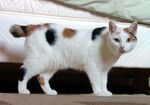Megacolon
Description
Megacolon is a state of permanently increased diameter of the large bowel. This change in intestinal structure leads to abnormal function, including reduced colonic motility and chronic constipation. The condition most commonly occurs in cats and dogs, but pigs can also be afffected. White foals suffering congenital colonic agangliosis, an autosomal recessive trait, may develop secondary megacolon.
In small animals, megacolon may be congenital or acquired, which may be idiopathic. Although well described in human medicine, congenital megacolon has not been convincingly described in animals despite first being reported in 19881. In man, Hirschsprung's disease manifests at a very young age is caused by an absence of inhibitory neurons in Meissner’s submucosal plexus and Auerbach’s myenteric plexus in the distal colon or rectum2. This gives persistent smooth muscle contraction in the affected region and proximal dilation of the colon. A similar pathogenesis is proposed in cats.
Acquired megacolon is more common than the congenital form, and in cats this is most often idiopathic. The true cause of "idiopathic" megacolon is thought to be an intrinsic defect in colonic smooth muscle function3. Aquired megacolon can occur in both cats and dogs as a sequel to any disease or lesion that interferes with normal defecation: faecal retention caused dilatation of the colon and impairs colonic motility. Causes could include neuromuscular abnormalities (spinal cord disease, intervertebral disk disease, dysautonomia, trauma), metabolic disorders (severe dehydration, hypokalaemia), drug therapy (vincristine, anticholinergics, barium), mechanical obstruction (pelvic fracture malunion, foreign bodies, stricture, anal/rectal atresia) and conditions causeing dyschezia (anal sacculitus, perianal fistula, trauma preventing posturing, procititis). After megacolon has persisted for several months, it is unlikely that normal colonic motility will be restored after resolution of the underlying cause. In many cases, the aetiology of megacolon is not determined.
Signalment
Megacolon much more commonly affects cats than dogs, but any age, breed or sex of animal may develop aquired megacolon. Idiopathic megacolon is more common in middle-aged to older cats, and there is some evidence for an increased risk in Manx cats due to a sacral spinal cord deformity.
Diagnosis
Clinical Signs
Idiopathic megacolon is likely to be a long-term, recurring problem, with clinical sgns presenting over months to years. In acquired megacolon, signs can be acute or chronic in onset. The primary sign of megacolon is constpation or obstipation (severe constipation caused by intestinal obstruction). Animals suffer tenesmus when defaecating and produce little or no faeces. Faeces that is expelled is very hard and dry, and animals defaecate less frequently. After prolonged tenesmus, a small amount of often mucoid diarrhoea may be expelled. Vomiting, anorexia and weight loss are other key features. On clinical examination, an enlarged colon packed with hard faeces is palpated within the abdomen. The animal may be dehydrated, and the hair coat rough. Digital anorectal examination is necessary, and confirms faecal impaction as well as potentially revealing an underlying obstructive cause.
Megacolon must be differentiated from other causes of palpable colonic masses. These could include adenocarcinoma, lymphoma or intussusception and can be distinugished on the basis of texture, rectal examination and diagnostic imaging. Tenesmus can be caused by colitis as well as megacolon, and palpation, rectal examination and imaging can again be used to exclude this, Dysuria or stranguria may also look similar to the tenesmus caused by megacolon. Palpation of the bladder and colon and urinalyis will help eliminate this differential diagnosis.
Laboratory Tests
Haematology and biochemistry may give evidence of dehydration, such as raised packed cell volume, total protein and urea/creatinine. A stress leukogram may also be seen. The duration of constipation may result in changes to blood electrolytes, and dehydration can lead to pre-renal azotaemia. Urinalysis should always be perfored to rule out lower urinary tract disease as a differential diagnosis and to check renal function in dehydrated animals.
There are no laboratory tests specific for megacolon.
Diagnostic Imaging
Plain radiographs should be taken of the abdomen and pelvis in an attempt to confirm megacolon and to investigate underlying causes. The enlarged, faces-filled colon is easily seen on these x-rays. Subsequent contrast studies or abdominal ultrasound may help identify an underlying cause, such as mural or obstructive masses.
Endoscopy
Colonoscopy may be necessary to rule out obstructive masses in the large intestinal wall or lumen.
Pathology
The colon is found to be dilated and impacted with faeces, with the most sever dilatation occuring in the transverse and descending colon4. Histologically, the colon is usually normal: the only cases in which histological abnormalities have been reported were mature adult cats, which is an atypical signalment for a congenital condition1,4,5. The histological findings in these cats were aganglionosis and absent myenteric ganglia.
Treatment
Prognosis
Links
References
- Rosin, E et al (1988) Subtotal colectomy for treatment of chronic constipation associated with idiopathic megacolon in cats: 38 cases (1979-1895). Journal of the American Veterinary Medical Association, 193, 850-853.
- Pratschke, K (2005) Surgical disease of the colon and rectum in small animals. In Practice, 27, 354-362.
- Washabau, R J and Stalis, I H (1996) Effects of cisapride on feline colonic smooth muscle function. American Journal of Veterinary Research, 57, 541-546.
- YODER, J. T., DRAGSTEDT, L. R. 2nd & STARCH, C. J. (1968) Partial colectomy for correction of megacolon in a cat. (Report of a case). Veterinary Medicine: Small Animal Clinics, 63, 1049-1052.
- LY, J T (1977) Surgical correction of megacolon in a cat. Australian Veterinary Practitioner, 7, 210.
